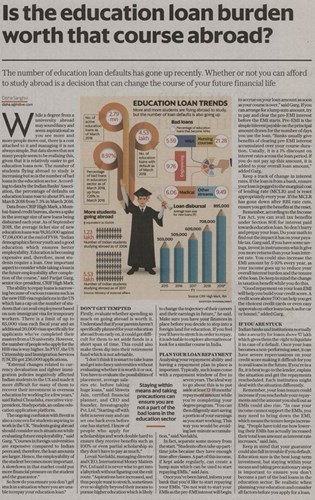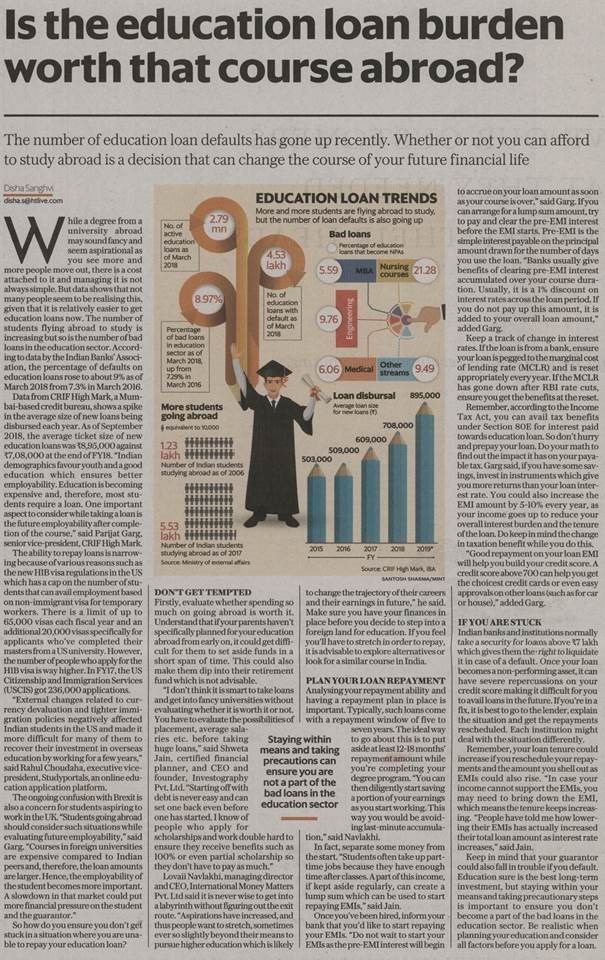Is The Education Loan Burden Worth That Course Abroad? - CRIF Insights
While a degree from a university abroad may sound fancy and seem aspirational as you see more and more people move out, there is a cost attached to it and managing it is not always simple. But data shows that not many people seem to be realising this, given that it is relatively easier to get education loans now. The number of students flying abroad to study is increasing but so is the number of bad loans in the education sector. According to data by the Indian Banks’ Association, the percentage of defaults on education loans rose to about 9% as of March 2018 from 7.3% in March 2016.
Data from CRIF High Mark, a Mumbai-based credit bureau, shows a spike in the average size of new loans being disbursed each year. As of September 2018, the average ticket size of new education loans was ₹8,95,000 against ₹7,08,000 at the end of FY18. “Indian demographics favour youth and a good education which ensures better employability. Education is becoming expensive and, therefore, most students require a loan. One important aspect to consider while taking a loan is the future employability after completion of the course," said Parijat Garg, senior vice-president, CRIF High Mark.
The ability to repay loans is narrowing because of various reasons such as the new H1B visa regulations in the US which has a cap on the number of students that can avail employment based on non-immigrant visa for temporary workers. There is a limit of up to 65,000 visas each fiscal year and an additional 20,000 visas specifically for applicants who’ve completed their masters from a US university. However, the number of people who apply for the H1B visa is way higher. In FY17, the US Citizenship and Immigration Services (USCIS) got 236,000 applications.
“External changes related to currency devaluation and tighter immigration policies negatively affected Indian students in the US and made it more difficult for many of them to recover their investment in overseas education by working for a few years," said Rahul Choudaha, executive vice-president, Studyportals, an online education application platform.
The ongoing confusion with Brexit is also a concern for students aspiring to work in the UK. “Students going abroad should consider such situations while evaluating future employability," said Garg. “Courses in foreign universities are expensive compared to Indian peers and, therefore, the loan amounts are larger. Hence, the employability of the student becomes more important. A slowdown in that market could put more financial pressure on the student and the guarantor."
So how do you ensure you don’t get stuck in a situation where you are unable to repay your education loan?
Don’t get tempted
Firstly, evaluate whether spending so much on going abroad is worth it. Understand that if your parents haven’t specifically planned for your education abroad from early on, it could get difficult for them to set aside funds in a short span of time. This could also make them dip into their retirement fund which is not advisable.
“I don’t think it is smart to take loans and get into fancy universities without evaluating whether it is worth it or not. You have to evaluate the possibilities of placement, average salaries etc. before taking huge loans," said Shweta Jain, certified financial planner, and CEO and founder, Investography Pvt. Ltd. “Starting off with debt is never easy and can set one back even before one has started. I know of people who apply for scholarships and work double hard to ensure they receive benefits such as 100% or even partial scholarship so they don’t have to pay as much."
Lovaii Navlakhi, managing director and CEO, International Money Matters Pvt. Ltd said it is never wise to get into a labyrinth without figuring out the exit route. “Aspirations have increased, and thus people want to stretch, sometimes ever so slightly beyond their means to pursue higher education which is likely to change the trajectory of their careers and their earnings in future," he said. Make sure you have your finances in place before you decide to step into a foreign land for education. If you feel you’ll have to stretch in order to repay, it is advisable to explore alternatives or look for a similar course in India.
Plan your loan repayment
Analysing your repayment ability and having a repayment plan in place is important. Typically, such loans come with a repayment window of five to seven years. The ideal way to go about this is to put aside at least 12-18 months’ repayment amount while you’re completing your degree program. “You can then diligently start saving a portion of your earnings as you start working. This way you would be avoiding last-minute accumulation," said Navlakhi.
In fact, separate some money from the start. “Students often take up part-time jobs because they have enough time after classes. A part of this income, if kept aside regularly, can create a lump sum which can be used to start repaying EMIs," said Jain.
Once you’ve been hired, inform your bank that you’d like to start repaying your EMIs. “Do not wait to start your EMIs as the pre-EMI interest will begin to accrue on your loan amount as soon as your course is over," said Garg. If you can arrange for a lump sum amount, try to pay and clear the pre-EMI interest before the EMI starts. Pre-EMI is the simple interest payable on the principal amount drawn for the number of days you use the loan. “Banks usually give benefits of clearing pre-EMI interest accumulated over your course duration. Usually, it is a 1% discount on interest rates across the loan period. If you do not pay up this amount, it is added to your overall loan amount," added Garg.
Keep a track of change in interest rates. If the loan is from a bank, ensure your loan is pegged to the marginal cost of lending rate (MCLR) and is reset appropriately every year. If the MCLR has gone down after RBI rate cuts, ensure you get the benefits at the reset.
Remember, according to the Income Tax Act, you can avail tax benefits under Section 80E for interest paid towards education loan. So don’t hurry and prepay your loan. Do your math to find out the impact it has on your payable tax. Garg said, if you have some savings, invest in instruments which give you more returns than your loan interest rate. You could also increase the EMI amount by 5-10% every year, as your income goes up to reduce your overall interest burden and the tenure of the loan. Do keep in mind the change in taxation benefit while you do this.
“Good repayment on your loan EMI will help you build your credit score. A credit score above 700 can help you get the choicest credit cards or even easy approvals on other loans (such as for car or house)," added Garg.
If you are stuck
Indian banks and institutions normally take a security for loans above ₹7 lakh which gives them the right to liquidate it in case of a default. Once your loan becomes a non-performing asset, it can have severe repercussions on your credit score making it difficult for you to avail loans in the future. If you’re in a fix, it is best to go to the lender, explain the situation and get the repayments rescheduled. Each institution might deal with the situation differently.
Remember, your loan tenure could increase if you reschedule your repayments and the amount you shell out as EMIs could also rise. “In case your income cannot support the EMIs, you may need to bring down the EMI, which means the tenure keeps increasing. “People have told me how lowering their EMIs has actually increased their total loan amount as interest rate increases," said Jain.
Keep in mind that your guarantor could also fall in trouble if you default. Education sure is the best long-term investment, but staying within your means and taking precautionary steps is important to ensure you don’t become a part of the bad loans in the education sector. Be realistic when planning your education and consider all factors before you apply for a loan.
Original Source: Live Mint


